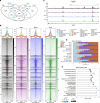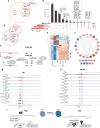The Fgf/Erf/NCoR1/2 repressive axis controls trophoblast cell fate
- PMID: 37137875
- PMCID: PMC10193302
- DOI: 10.1038/s41467-023-38101-8
The Fgf/Erf/NCoR1/2 repressive axis controls trophoblast cell fate
Abstract
Placental development relies on coordinated cell fate decisions governed by signalling inputs. However, little is known about how signalling cues are transformed into repressive mechanisms triggering lineage-specific transcriptional signatures. Here, we demonstrate that upon inhibition of the Fgf/Erk pathway in mouse trophoblast stem cells (TSCs), the Ets2 repressor factor (Erf) interacts with the Nuclear Receptor Co-Repressor Complex 1 and 2 (NCoR1/2) and recruits it to key trophoblast genes. Genetic ablation of Erf or Tbl1x (a component of the NCoR1/2 complex) abrogates the Erf/NCoR1/2 interaction. This leads to mis-expression of Erf/NCoR1/2 target genes, resulting in a TSC differentiation defect. Mechanistically, Erf regulates expression of these genes by recruiting the NCoR1/2 complex and decommissioning their H3K27ac-dependent enhancers. Our findings uncover how the Fgf/Erf/NCoR1/2 repressive axis governs cell fate and placental development, providing a paradigm for Fgf-mediated transcriptional control.
© 2023. The Author(s).
Conflict of interest statement
The authors declare no competing interests.
Figures






Similar articles
-
Suppression of Fgf2 by ETS2 repressor factor (ERF) is required for chorionic trophoblast differentiation.Mol Reprod Dev. 2017 Apr;84(4):286-295. doi: 10.1002/mrd.22780. Epub 2017 Feb 28. Mol Reprod Dev. 2017. PMID: 28244611
-
Transcriptional repressor erf determines extraembryonic ectoderm differentiation.Mol Cell Biol. 2007 Jul;27(14):5201-13. doi: 10.1128/MCB.02237-06. Epub 2007 May 14. Mol Cell Biol. 2007. PMID: 17502352 Free PMC article.
-
A cell type-specific expression map of NCoR1 and SMRT transcriptional co-repressors in the mouse brain.J Comp Neurol. 2020 Sep 1;528(13):2218-2238. doi: 10.1002/cne.24886. Epub 2020 Feb 24. J Comp Neurol. 2020. PMID: 32072640 Free PMC article.
-
Transcription factors underlying the development and endocrine functions of the placenta.Recent Prog Horm Res. 2002;57:221-34. doi: 10.1210/rp.57.1.221. Recent Prog Horm Res. 2002. PMID: 12017545 Review.
-
NCOR1-a new player on the field of T cell development.J Leukoc Biol. 2018 Dec;104(6):1061-1068. doi: 10.1002/JLB.1RI0418-168R. Epub 2018 Aug 17. J Leukoc Biol. 2018. PMID: 30117609 Review.
Cited by
-
ISRIB facilitates the co-culture of human trophoblast stem cells and embryonic stem cells.Cell Prolif. 2024 Jun;57(6):e13599. doi: 10.1111/cpr.13599. Epub 2024 Jan 12. Cell Prolif. 2024. PMID: 38217296 Free PMC article.
-
Identification of functional non-coding variants associated with orofacial cleft.Nat Commun. 2025 Jul 16;16(1):6545. doi: 10.1038/s41467-025-61734-w. Nat Commun. 2025. PMID: 40670354 Free PMC article.
-
Heterozygous variants disrupting the interaction of ERF with activated ERK1/2 cause microcephaly, developmental delay, and skeletal anomalies.Eur J Hum Genet. 2025 Jun;33(6):718-726. doi: 10.1038/s41431-024-01721-9. Epub 2024 Dec 12. Eur J Hum Genet. 2025. PMID: 39668184
References
Publication types
MeSH terms
Substances
LinkOut - more resources
Full Text Sources
Molecular Biology Databases
Research Materials
Miscellaneous

